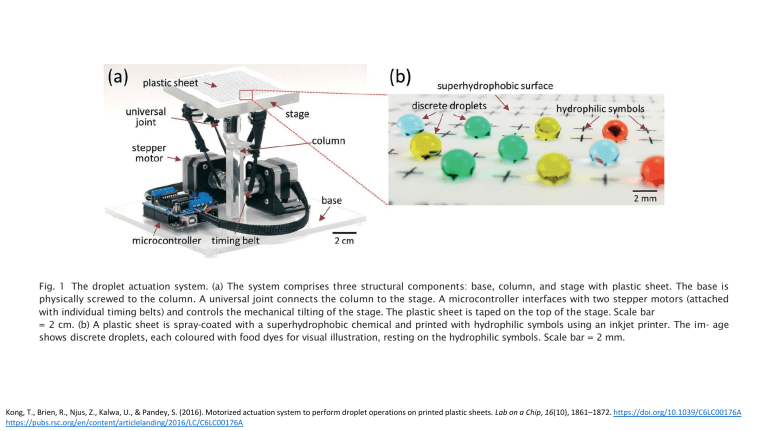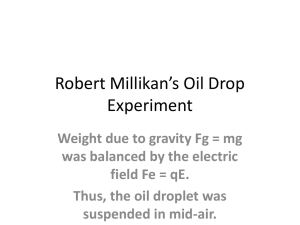
Fig. 1 The droplet actuation system. (a) The system comprises three structural components: base, column, and stage with plastic sheet. The base is
physically screwed to the column. A universal joint connects the column to the stage. A microcontroller interfaces with two stepper motors (attached
with individual timing belts) and controls the mechanical tilting of the stage. The plastic sheet is taped on the top of the stage. Scale bar
= 2 cm. (b) A plastic sheet is spray-coated with a superhydrophobic chemical and printed with hydrophilic symbols using an inkjet printer. The im- age
shows discrete droplets, each coloured with food dyes for visual illustration, resting on the hydrophilic symbols. Scale bar = 2 mm.
Kong, T., Brien, R., Njus, Z., Kalwa, U., & Pandey, S. (2016). Motorized actuation system to perform droplet operations on printed plastic sheets. Lab on a Chip, 16(10), 1861–1872. https://doi.org/10.1039/C6LC00176A
https://pubs.rsc.org/en/content/articlelanding/2016/LC/C6LC00176A
Fig. 2 Transport mechanism of a single droplet. (a) In the cartoon, a droplet is initially positioned on the left hydrophilic symbol printed on the
superhydrophobic surface of a plastic sheet. The stage is tilted clockwise and then anti-clockwise to return to its default horizontal position
(depicted by red block arrows). This rapid tilting action en- ables the droplet to move to the right hydrophilic symbol. (b) Time- lapsed images of an
actual droplet show how the droplet is trans- ported from the left symbol to the right symbol by the tilting action of the stage. The vertical dotted
lines represents the starting position of the droplet. Scale bar = 1 mm.
Kong, T., Brien, R., Njus, Z., Kalwa, U., & Pandey, S. (2016). Motorized actuation system to perform droplet operations on printed plastic sheets. Lab on a Chip, 16(10), 1861–1872. https://doi.org/10.1039/C6LC00176A
https://pubs.rsc.org/en/content/articlelanding/2016/LC/C6LC00176A
Fig. 3 Transport of multiple droplets: a series of images are taken to illustrate the movement of multiple droplets on an arrangement of plus
symbols. The volume of each droplet is 10 μL and they are uniquely coloured with a food dye for visual illustration. The motor speed is 100 r.p.m.
and the number of steps is 14. The direction of tilting the stage at every step is denoted by a red arrow. The stage is rapidly tilted twice in left
direction (a, b) and three times in the downward direction (c–e). The final positions of all droplets are shown in (f). This demonstration shows that
multiple droplets can be simultaneously moved in the same direction without any risk of cross- contamination. Scale bar = 0.5 cm.
Kong, T., Brien, R., Njus, Z., Kalwa, U., & Pandey, S. (2016). Motorized actuation system to perform droplet operations on printed plastic sheets. Lab on a Chip, 16(10), 1861–1872. https://doi.org/10.1039/C6LC00176A
https://pubs.rsc.org/en/content/articlelanding/2016/LC/C6LC00176A
Fig. 4 Transport of large droplets: (a) a large blue droplet (volume = 80 μL) is moved using a 2 × 2 array of plus symbols (line width is 0.0178 cm,
line length is 0.24 cm, and inter-array spacing is 0.68 cm). Compared to Fig. 3 where 10 μL droplets were moved, here the motor speed is decreased
and the number of steps is increased (80 r.p.m., 20 steps) to move the 80 μL droplet. (b) A large green droplet (volume = 300 μL) is being transported
to the neighbouring pattern using a 3 × 3 array of plus symbols. As in (a), the motor speed is decreased and the number of steps is increased (60 r.p.m.,
25 steps) compared to those in Fig. 3. By using the same scheme and adjusting the parameters of stepper motors, up to 1 mL droplets have been
transported. Scale bar
= 0.5 cm.
Kong, T., Brien, R., Njus, Z., Kalwa, U., & Pandey, S. (2016). Motorized actuation system to perform droplet operations on printed plastic sheets. Lab on a Chip, 16(10), 1861–1872. https://doi.org/10.1039/C6LC00176A
https://pubs.rsc.org/en/content/articlelanding/2016/LC/C6LC00176A
Fig. 5 Merging and mixing of multiple droplets. (a) A two-dimensional arrangement of plus symbols is shown where the line width is thinnest in the left
two columns, medium thickness in the middle two columns, and thickest in the right two columns. Three droplets (yellow, red, and blue) are placed on
the plus symbols. The red arrow indicates the di- rection of tilting the stage and the stage is tilted in the following se- quence: downwards, right,
right, downwards, and right. The yellow droplet is moved to and merged with the red droplet (a–c). This merged droplet is now moved and merged
with the blue droplet (d–e) and the final product after merging all droplets is shown in (f). After the merging step, the stage can be agitated to mix the
combined drop- lets. Scale bar = 0.5 cm.
Kong, T., Brien, R., Njus, Z., Kalwa, U., & Pandey, S. (2016). Motorized actuation system to perform droplet operations on printed plastic sheets. Lab on a Chip, 16(10), 1861–1872. https://doi.org/10.1039/C6LC00176A
https://pubs.rsc.org/en/content/articlelanding/2016/LC/C6LC00176A
Fig. 6 (a) Each droplet is placed on two different symbols (plus and greater-than sign). The droplet on the plus symbol moves to the left when
rapidly tilted to the left, but the droplet on the greater-than symbol does not move. When the substrate rapidly tilts to the right, both droplets on
the plus symbol and the greater-than symbol move to the right. The acute point of the greater-than symbol has less hy- drophilic area to attract the
droplet. (b) Slow motion images showing different configurations of the droplet when the stage rapidly tilts to the left and right directions. When the
stage tilts left, the two diagonal lines attached to the large area of the droplet prevent it from moving to next symbol. When the stage tilts right, a sharp
point (where two di- agonal lines meet) attaches to a small area of the droplet and the droplet is released to the next symbol. (c) One directional
movement: the droplet only moves to the right due to the pattern of three con- verging greater-than symbols pointing to the center. Scale bar = 0.5
cm.
Kong, T., Brien, R., Njus, Z., Kalwa, U., & Pandey, S. (2016). Motorized actuation system to perform droplet operations on printed plastic sheets. Lab on a Chip, 16(10), 1861–1872. https://doi.org/10.1039/C6LC00176A
https://pubs.rsc.org/en/content/articlelanding/2016/LC/C6LC00176A
Fig. 7 Droplet dispensing from a large droplet (volume = 10 μL): (a) A small red droplet is dispensed on each circular dot hydrophilic symbol. While a
large droplet moves over the hydrophilic dots, each symbol attracts the droplet and a small volume is left on each symbol. (b) Small red droplets are
dispensed on rectangular-shaped hydrophilic symbols. (c) Small red droplets are dispensed on diamond-shaped hydrophilic symbol.
(d) After the dispensing operation on circular dot symbols, a clear water droplet is transported across the dot symbols, causing the red colour
intensity to increase in the clear droplet. Scale bar = 0.5 cm.
Kong, T., Brien, R., Njus, Z., Kalwa, U., & Pandey, S. (2016). Motorized actuation system to perform droplet operations on printed plastic sheets. Lab on a Chip, 16(10), 1861–1872. https://doi.org/10.1039/C6LC00176A
https://pubs.rsc.org/en/content/articlelanding/2016/LC/C6LC00176A
Fig. 8 Dispensing droplets from an external reservoir: (a) the reservoir is placed along the edge of the stage. (b) A dispenser tip is pressed by tilting
the stage. (c) While the tip is pushed up, liquid flows out through the opened entrance of the reservoir. (d) A dispensed droplet is transported to
another symbol and the next droplet is dispensed. (e, f) By tilting the stage twice, a larger droplet is dispensed in the same location. Scale bar = 1 cm.
Kong, T., Brien, R., Njus, Z., Kalwa, U., & Pandey, S. (2016). Motorized actuation system to perform droplet operations on printed plastic sheets. Lab on a Chip, 16(10), 1861–1872. https://doi.org/10.1039/C6LC00176A
https://pubs.rsc.org/en/content/articlelanding/2016/LC/C6LC00176A
Fig. 9 Glucose detection on the droplet actuation system. (a) Glucose standards of different concentrations are placed on the middle column of plus
symbols and the glucose reagents are placed on the leftmost column. (b) The stage is tilted to the right and the two columns of droplets merge on
the middle column. (c) The merged droplets settle on the third column. (d–g) The stage is agitated in multiple directions to mix the combined
droplets. (h–j) The merged droplets are incubated for the chemical reaction and the colour change is visible after around 10 seconds of incubation. The
colour intensity is darker for droplets having higher glucose concentrations. Scale bar = 0.5 cm.
Kong, T., Brien, R., Njus, Z., Kalwa, U., & Pandey, S. (2016). Motorized actuation system to perform droplet operations on printed plastic sheets. Lab on a Chip, 16(10), 1861–1872. https://doi.org/10.1039/C6LC00176A
https://pubs.rsc.org/en/content/articlelanding/2016/LC/C6LC00176A
Fig. 10 Determination of glucose concentrations in sheep serum. (a) The colour intensities of incubated droplets at different time points are shown.
Each glucose concentration is tested three times (n = 3). (b) The maximum slope of each colour intensity graph at different glucose concentrations
is plotted to obtain the standard curve equation and to determine the glucose concentration in sheep serum.
Kong, T., Brien, R., Njus, Z., Kalwa, U., & Pandey, S. (2016). Motorized actuation system to perform droplet operations on printed plastic sheets. Lab on a Chip, 16(10), 1861–1872. https://doi.org/10.1039/C6LC00176A
https://pubs.rsc.org/en/content/articlelanding/2016/LC/C6LC00176A




